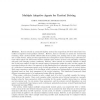Free Online Productivity Tools
i2Speak
i2Symbol
i2OCR
iTex2Img
iWeb2Print
iWeb2Shot
i2Type
iPdf2Split
iPdf2Merge
i2Bopomofo
i2Arabic
i2Style
i2Image
i2PDF
iLatex2Rtf
Sci2ools
APIN
1998
1998
Multiple Adaptive Agents for Tactical Driving
Abstract. Recent research in automated highway systems has ranged from low-level vision-based controllers to high-level route-guidance software. However, there is currently no system for tactical-level reasoning. Such a system should address tasks such as passing cars, making exits on time, and merging into a traffic stream. Many previous approaches have attempted to hand construct large rule-based systems which capture the interactions between multiple input sensors, dynamic and potentially conflicting sub-goals, and changing roadway conditions. However, these systems are extremely difficult to design due to the large number of rules, the manual tuning of parameters within the rules, and the complex interactions between the rules. Our approach to this intermediate-level planning is a system which consists of a collection of autonomous agents, each of which specializes in a particular aspect of tactical driving. Each agent examines a subset of the intelligent vehicle’s sensors and i...
APIN 1998 | Different Reasoning Agents | Large Rule-based Systems | Low-level Vision-based Controllers |
| Added | 21 Dec 2010 |
| Updated | 21 Dec 2010 |
| Type | Journal |
| Year | 1998 |
| Where | APIN |
| Authors | Rahul Sukthankar, Shumeet Baluja, John Hancock |
Comments (0)

